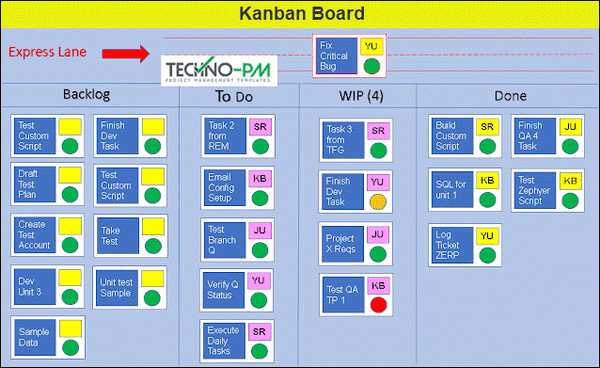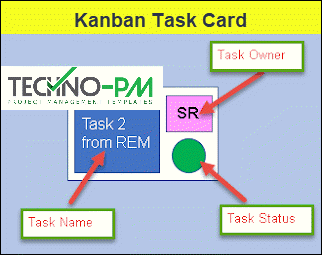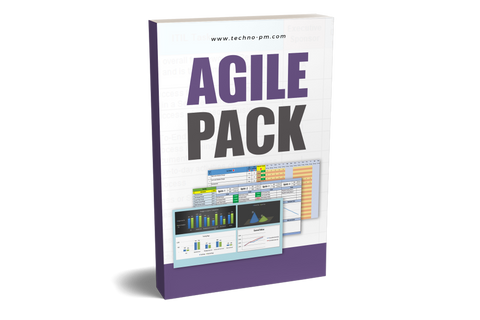What is a Kanban Board and How Do You Use Kanban Template?
Kanban Board
Kanban is a simple but yet potent tool for the management of the workload of a team. Using Kanban board provides visibility and structure to the way a team manages its workload. Kanban has recently grown in popularity and is perhaps one of the most popular applications of an Agile mindset, being widely used as a methodology for managing project work in the industry of software development, but not limited to it.

Kanban Board Template - PowerPoint
What is Kanban?
While everyone seems to be talking about or adopting Kanban nowadays, Kanban is not new and dates to the late 40s. Nearly 60 years ago, Toyota, the giant car manufacturer, had a play at it in an attempt to optimize its operations in an equivalent way to how supermarkets replenish their stock – no sooner, no later, but just in time (JIT)! The JIT methodology approach was born and, with it, a set of principles, behaviors, and practices that made it successful.
Among them, Kanban. Kanban is a Japanese word that can be translated as ‘visual signal.’ The saying goes that ‘pictures are worth a thousand words, which is exactly the essence of Kanban, where work items are represented visually on a board, allowing team members to track the progress of work and quickly identify bottlenecks dependencies between them.
As a methodology, Kanban is underpinned by three fundamental principles:
Visualize the workflow: On the wall, on the screen, or on paper, visuals are a key concept for Kanban. For Kanban to be properly applied, work and its flow need to be visually represented in some form, helping to identify how work progresses and which work items are in the queue.
Limit work in progress: Don’t try to bite off more than can chew; by limiting the amount of work in progress (WIP), Kanban ensures that teams commit to works according to their capacity, avoiding a scenario everyone is working, but nothing gets done.
Focus on flow: The journey matters more than the individual stops on the way, and focus should be put on how the teams allow work to progress in the backlog until their completion.
How Does a Kanban Board Work?
The Kanban team's main tool is the Kanban board, which is used to visualize and optimize the flow of work in the team. In its simplest form, a Kanban board is usually split between ‘To Do,’ In Progress,’ and ‘Done.’ As work progresses, teams start moving a card (a single task) from the left (your To-Do list) to the right on the board (your Done list), in this way signaling tasks in the workflow until they reach completion.
Kanban boards can be physical (colorful sticky notes are always an excellent choice!) or digital (I’m certain you’ve heard of Trello before), but, regardless of their format, they should allow the workflow to be standardized and easily visualized.
With all work clearly displayed on a board, the Kanban team can then quickly move items around and check what needs to be done next, how many items are in progress and how do they impact the team’s capacity, what the overall progress looks like, how big is the queue of items still to be completed and, as importantly, identify priority conflicts and bottlenecks and collaboratively discuss how to get the work flowing again.
What Are The Benefits of Kanban?
Easy to apply and understand: While Gantt Charts can scare even the most competent and experienced senior manager, Kanban boards are simple and very visual, making it easy, even for someone new on the role, to get what it is about.
Transparency: It’s difficult to hide problems when they are just before your eyes. On a wall. With colors. Provide visibility to the current team workload, including the backlog. Each team member knows what others in the team are working on and the status of the task. As the backlog is clearly visible manager can take actions to handle the workload.
Focus and speed: By having a clear status for each work item, the team can focus on items that are in progress, in this way, quickly moving forward in the workflow. You can use the express lane to prioritize items that are urgently required. Increased productivity as a team is more focused on tasks.

Kanban Columns
Columns on a Kanban Board
Backlog - will contain the list of all the tasks pending. All the items on the backlog should be approved by key stakeholders. Before any item is added to the backlog, it must have the requirements defined. All the tasks should come with an end date or time. All the tasks should come with priority.
To-Do - will contain tasks that are already prioritized. Add items only after assigning them an owner and is prioritized for work. Ensure the task's right status is reflected in other tracking systems like MS Project, Team Backlog.
Download a free To-Do list template.
WIP - Work In Progress. Tasks that are currently in progress. This also a max number which indicates the max number of tasks that can be in in-progress. Move tasks only when they can be worked on. Ensure the card has the name of the person working on that task. Adhere to the max columns strictly so that team is not overloaded. Ensure the team updates the task status daily.
Done - Section which should have all the tasks which are complete. Move tasks only when all the aspects of it are complete. Example no defects outstanding, code review complete, task closed in JIRA, etc. Mark all the tasks as complete - which is green.
Express Lane - all urgent tickets should be put on this lane so that they can move faster. Add tasks here only when they are urgent. Ensure there is a valid reason for the emergency. The person working on the express lane items should not be assigned any other tasks.
Every task on the board is represented by a "Task card." The task card contains the name of the task, the Initials of the person working on it, and the current status - red, green, and amber. Define max threshold levels for each column. For example, Backlog can have a max of 20 tasks, To-Do a max of 5, etc.
Steps To Implement Kanban For Four Team
So, you read this article and are now looking forward to getting started with Kanban. Where to start? Fortunately, Kanban is a simple methodology; therefore, its adoption involves a set of simple steps:
1. Select what you are applying Kanban to: is it a process, a project, or a set of deliverables?
2. Identify what states are going to be used: use the 3 basic states of To Do, WIP, and Done, to start with
3. Define what Done looks like: it may sound common sense but, trust me, common sense is not that common.
4. Build a Kanban board: use a digital tool or put a board on the office wall.
Grab a bunch of sticky notes: distribute these to the Kanban team.
5. Define the Kanban cards: as a team, look at the product backlog and break down the work scope.
6. Assign estimates and people to the Kanban cards: time to make it real
Move cards based on their progress: every time a card is completed or a new one starts, the Board should be updated
7. Continuously improve: when using the tool in anger, you can start collecting metrics on the workflow and delivery cycle and use learning to continuously improve and refine the approach.
8. Relax and have fun: don’t be afraid to make mistakes; Kanban is a lot about experimentation and enjoying the fun that comes with collaboration!

Kanban Task Cards
Swimlanes in Kanban
While a basic Kanban board contains just three groups – To Do, In Progress, and Done -, due to the complexity of the project or based on the reporting and governance arrangements of your organization, this simple structure may be of limited use for you. In that case, it’s useful to know that you can always sophisticate your board a bit more. Two of the most common options include:
- Introduce additional states: if ‘In Progress’ falls short of what you aim to achieve, consider adding more columns to the board in line with your company’s established stages or states, such as ‘In Revision,’ ‘Testing,’ ‘Dispatched,’ etc.
- Introduce swimlanes: swimlanes represent a horizontal categorization that can allow you to gain a better overview of your tasks by displaying more information. Swimlanes can be quite helpful to split your board into teams, products, business areas, or assignees.
Although additional columns and swimlanes can assist in better tracking the work, you should remember the key advantage of using a Kanban board in the first place: keep it simple!
What Are Kanban Cards?
Each work item is represented as a Kanban card - the colorful sticky note you would add to the Kanban board. A Kanban card's main purpose is to visually display a work item flowing through the project, saving time in dreadful project meetings or lengthy status reports. However, make no mistake: Kanban cards should enable conversation, not replace them!
Typically, a Kanban card contains the following elements as a minimal:
- Unique identifier
- Name of the work item
- Start date
- Deadline, if applicable.
- Estimated duration
- Responsible
In a manufacturing environment – it was where it all started, after all! – Kanban cards can also be called Kanban Replenishment Cards, in this case containing additional information regarding the replenishment. Regardless, they both serve the same purpose: identify and define a piece of work to be tracked in the workflow.
Best Practices for a Kanban Board
- Update the Kanban every day with a 15 minutes meeting also called MOM with the team. This is mandatory and has to be done every day without fail.
- Encourage the team to move their tasks during the meeting.
- Only one person can add tasks to the backlog. This will ensure control over backlog.
- Always discuss the task in Express Lane first and give top priority to it.
- Always adhere to the max number defined for each of the columns. In our example, we have set a limit of 4 tasks for the WIP column.
- Ensure you have translation rules for each column. Check out below for some sample rules.
- Do not immediately delete the tasks in the done section. Keeping the tasks there makes the team and others see what was accomplished recently.
Personal Kanban
Life can be complicated sometimes, and that is where using a Kanban board for your personal use can be a great ally. Yes, Kanban can be used at the personal level, too, and we actually tend to do it unconsciously in our heads every time.

Personal Kanban Template
Not just can we organize our day-to-day more productively, it also contributes to our motivation by identifying how much we have accomplished on the day – unless, of course, you are a procrastinator and have a thousand work items in progress all at once!




